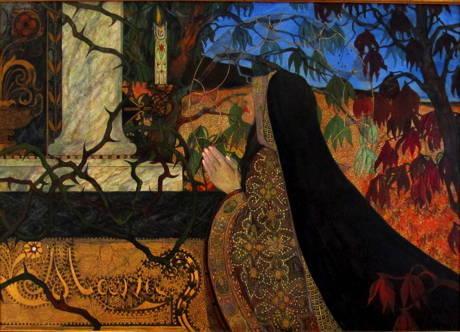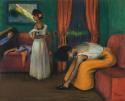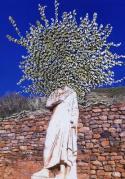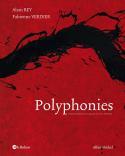Art Of The Day Weekly
#484 - from 28 September 2017 to 4 October 2017

Carl Strathmann, Maria, 1897, oil on canvas, Weimar, Kunstsammlung (Secessioni at Palazzo Roverella, Rovigo).
IN THE AIR
What secession means
Movies and painting often give us interesting links to decipher international events. One example can be seen in how the dangerous gesticulations by Trump and by the North- Korean dictator bring to mind images of Doctor Strangelove by Stanley Kubrick, in which sorcerer’s apprentices are overcome by their atomic toys. In the case of the referendum called by Catalonia on 1 October, and considered illegal by the government in Madrid, the term of secession brings to mind other similar situations. While in History it refers to the American civil war from 1861-65 (or that of Biafra, a century later, for the more erudite), it also has an equivalent in art history: the Viennese Secession in 1897 that aimed at breaking away from academic rigidity, traditions and salons. A current retrospective at Rovigo, in Italy, tells us how the term became very fashionable and led to many other versions throughout Europe: be it in a more precocious manner in 1892, in Prague or in Rome. This was actually a divorce without too many consequences since the dissident artists - Klimt, von Stuck or Klinger – were all allowed to come back into the fold of official art. Nothing similar in the political realm, in which the “rewind” button is not operational. Tensions are aggravated: those who leave do so because they feel their freedom is limited, while those who stay know there is no possible return. Pictorial avant-gardes have artificially softened the stringent aspect of the term which remains very strong.
• Secessioni europee at Palazzo Roverella, in Rovigo, from 23 September 2017 to 21 January 2018.
EXHIBITIONS
Lessons by Jean Rouch
PARIS - He was an engineer who blew up bridges and left behind unforgettable images of Berlin in 1945. An explorer who went down the Niger River in a dug-out canoe, who then shot 180 movies and in doing so invented reality cinema. He was also an ethnologist who penetrated some of the most secret rites of possession in Africa, but also deciphered the tribes in Saint-Germain-des-Prés. Jean Rouch (1917-2004) was all of that and more. The exhibition organized for the centennial of his birth in the immense passageways of the Bibliothèque nationale de France in Paris is worthy by the pieces it presents – biographical panels, excerpts of movies, a few exploration notebooks or hand-written scenarios, his first Bell&Hovell camera, or the surprising “sgubbitophone”, to record sounds live – as much as by the character it brings back to life. Jean Rouch was nourished on surrealism and the first tentative steps of cinema (Nanook by Flaherty, the first movie he saw, was a true revelation). He was relentlessly active for the nearly eight decades that followed. His camera was mounted on batteries and became a natural part of him, a sort of appendix, with which he immortalized the hunting of the hippopotamus, the huge market of Kumasi in Accra, as well as his friendship with Joris Ivens, Manoel de Oliveira or Raymond Depardon. In his travels near and far, he was forever curious, a unique quality, and demonstrated empathy and a refreshing subjectivity. When witnessing the acceleration of our ways of life, he would remind those who stopped to listen that the road to one another is not covered by plane, nor by car, nor by boat. Simply on foot.
• Jean Rouch, l’homme-cinéma at the Bibliothèque nationale de France, from 26 September to 26 November 2017.
• The catalogue Jean Rouch, l’homme-cinéma, directed by Béatrice de Pastre (Somogy/BnF, 254 p., €29), examines his 180 films.
ELSEWHERE IN EUROPE
BASEL – Various exhibitions have endeavored to show the links between Paul Klee and music, the Bauhaus movement, travels to Tunisia, be it to irony –like in a recent exhibition at the Centre Pompidou. Strangely enough, the obvious links between Klee and abstraction have rarely been studied. The Beyeler Foundation, which owns some twenty works by the artist, is busy doing so. From 1st October 2017 to 21 January 2018.
BARCELONA - Ramon Pichot (1871-1925) was a friend and contemporary of Picasso. Like the famous artist, he too left to Paris in search of a better life. And he died there. The MNAC shows a painter with a passion for society, a great colorist, a companion of the Fauvist artists – he took part in the famous Salon that created such a scandal in 1905 -, which is not yet given the place it deserves. From 29 September 2017 to 21 January 2018.
LONDON - Jasper Johns, born in 1930, is one of the last sacred monsters of the Pop Art still alive. The Royal Academy dedicates a retrospective to the specialist of flags and targets with nearly 150 works. From 23 September to 10 December 2017.
STRASBOURG - Strasbourg 1880-1930: on the first date, the town is freshly German. On the second date it had already come back to France for ten years. While these fifty years were moments of great changes, they also nourished the creativity of artists and town developers. A series of exhibitions explores different themes. From 24 September 2017 to 25 February 2018.
TOULOUSE - Medellín used to give people cold sweat. The former capital of Escobar’s drug cartel led an impressive urban renovation over a period of two decades, including the metro, tram, museums, parks, and libraries, which also gave a new life to the artistic scene. During the year of Columbia in France, the Musée des Abattoirs studies this interesting and unique case. From 29 September 2017 to 21 January 2018.
ARTIST OF THE WEEK
Raphaëlle Peria, photography with a gouge
Young artist Raphaëlle Peria - born in 1989 –combines the clinical veracity of a photograph with the work of a manual craftsman. She also makes the leaves of an olive tree in Anatolia shiver in a laser reproduction. This is what we can see in her exhibition Marinus Asiaticus. The young woman meets a great challenge, as she digs out a photograph reproduced on a solid support with a gouge. By pruning the tree through small slits, she creates different foliage; she invents other furrows in the fields, other flows in the waterfall, and other snow avalanches in the mountain. All of them are less realistic but all are more meaningful. One could go on and on about the philosophical dimension of the act – the loss of matter as a means of reaching a form of truth. We prefer to savor the successful movement, and the emotion derived from these images in which a few fragile beards float like living matter.
• Raphaëlle Peria’s work was exhibited until 27 September 2017 at Claudine Papillon (13, rue Chapon, 75003).
OPENINGS OF THE WEEK

Vincent Pérez - Un voyage en Russie
29 September 2017 - PARIS - Galerie Folia
Before acting, Vincent Pérez studied photography and never relinquished his passion
BOOKS
The Robert dictionary in sign language
An ardent lexicographer and a painter fascinated by Oriental calligraphy have special ways of conversing. They simply get together around an essential theme, language. What written words say can also be expressed by a gesture. For the 50th edition of the famous Petit Robert, its creator Alain Rey worked together with Fabienne Verdier, who was trained by the great Chinese brush masters. Together they chose some essential couples of words which hold concepts from which many others may ensue. Arborescence-Allegory, Labyrinth-Liberty or Rhythm-Reflection: they open the door to wise written thought (Rey) and to signs that sum them up (Verdier). This specular and analogic procedure is very stimulating. But we must admit it is very complex. We would have appreciated a bit of a slowdown, such as Facility-Fluidity or Simplicity-Flexibility – to guide us.
• Polyphonies, by Alain Rey and Fabienne Verdier, Le Robert/Albin Michel, 2017, 217 p., €59.




